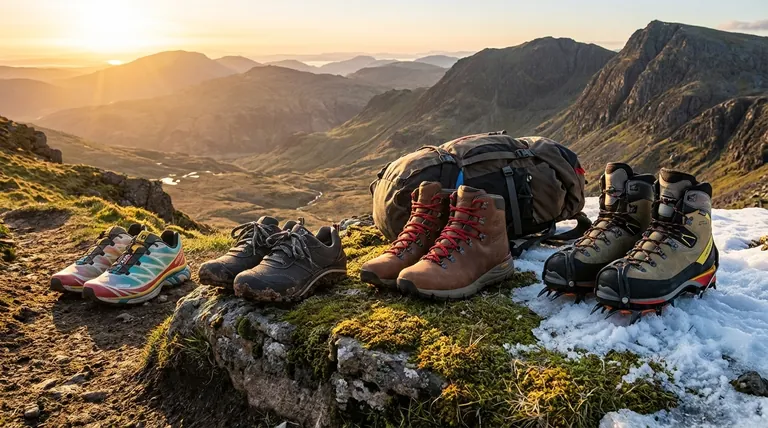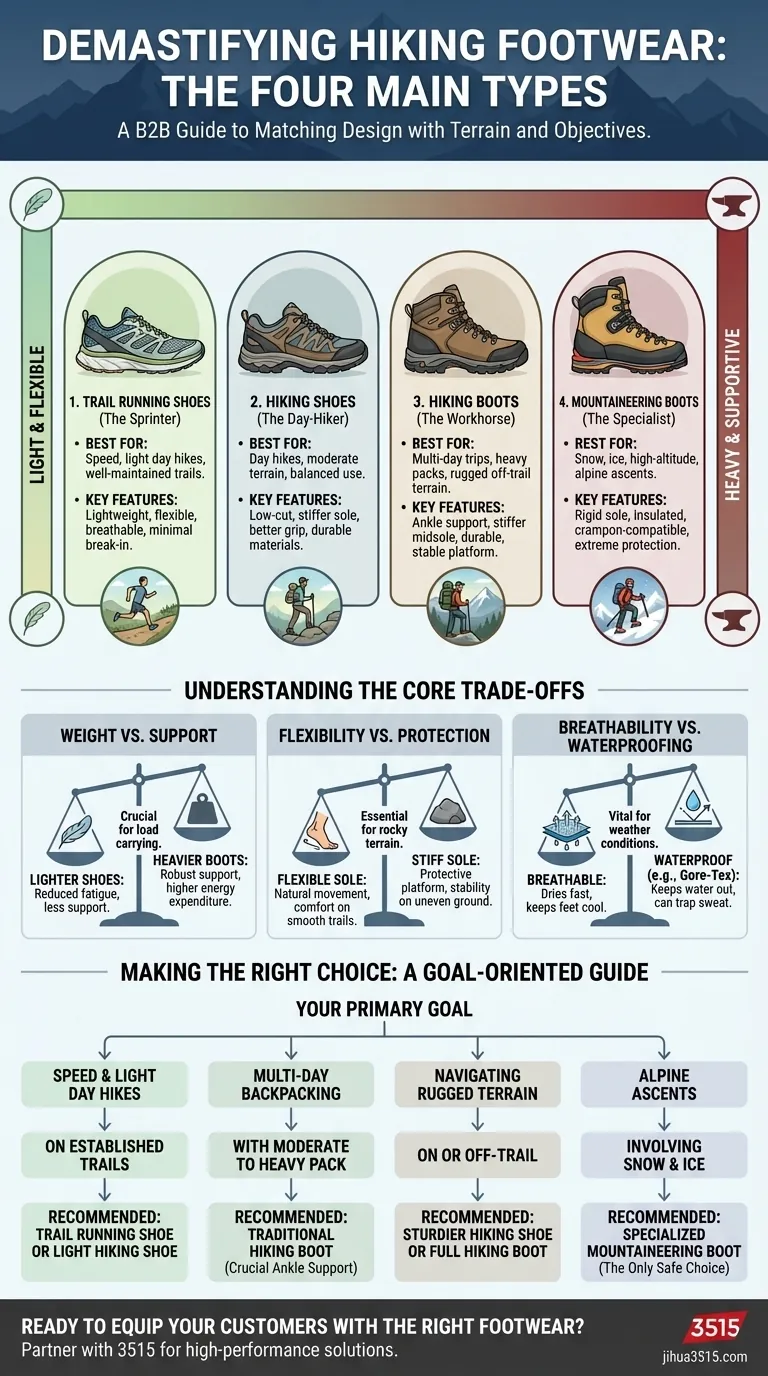Okay, so the user wants the lowdown on the four main types of hiking shoes. This requires some serious synthesis, as the sources seem to approach categorization from slightly different angles. My immediate goal is to give a clear, definitive list that's useful. I'll focus on use case and cut/height to synthesize the information into a practical model for the user, an expert. I'm thinking the most helpful breakdown will be: Trail Running Shoes, Hiking Shoes, Hiking Boots, and Mountaineering Boots. I need to make sure I cover the user's deep need - how to choose the right shoe for them.
I'll start with a straightforward answer, then dive into the reasoning. My opening will be direct, and the answer will be crystal clear. Then, I'll explain that the best shoe isn't one-size-fits-all. It's about how well the shoe's design (support, weight, stiffness) matches the hiker's specific needs, and the demands of the terrain.
I'm structuring this as a spectrum, from lightweight and flexible to heavy-duty and supportive. I'll use headings for each type, providing a clear breakdown of each.
- Trail Running Shoes: These are light, flexible, and breathable. Perfect for day hikes and fastpacking on well-maintained trails. I'll highlight their softness, as that's key.
- Hiking Shoes: The middle ground. Low-cut but stiffer than trail runners, with better grip. Ideal for day hikes on moderate trails.
- Hiking Boots: Mid- or high-cut, with ankle support and stiffer soles. Essential for heavy packs, rough terrain, and multi-day trips. I'll emphasize ankle stability.
- Mountaineering Boots: The most robust category, rigid, insulated, and crampon-compatible for high-altitude conditions.
The key is to discuss the trade-offs. The user needs to understand that there is no perfect shoe, just the "right" shoe. I will be very clear with my explanations:
- Weight vs. Support: Heavier boots offer more support, but also more fatigue. Lighter shoes are great for fatigue but may offer less protection and stability.
- Flexibility vs. Protection: Flexible soles are comfortable but offer less protection from rocks, while stiff soles protect the foot, but can be awkward on easier trails.
- Breathability vs. Waterproofing: A classic dilemma. Breathable shoes dry faster but get wet. Waterproof membranes keep water out but can trap sweat.
I'll close with actionable advice, guiding the user towards a decision. I'll make goal-oriented recommendations: Trail Runners for speed, Hiking Boots for support with a heavy pack, sturdier boots for rough terrain, and Mountaineering Boots for the alpine environment. I'll empower the user to make an informed choice. I want them to feel confident and ready to hit the trail.
I'll refine the information, discarding any vague categorizations. Using clear, industry-standard terms (Hiking Shoes, Hiking Boots, Trail Runners, Mountaineering Boots). I will use cut designations from the resources to help with classification. My tone will be expert, objective, clear, and empowering. Avoiding jargon and keeping it simple. The four primary types of hiking footwear are trail running shoes, hiking shoes, hiking boots, and mountaineering boots. While many sub-categories exist, these four cover the vast majority of use cases, with each one representing a different balance of weight, support, and protection designed for specific types of terrain and objectives.
The core principle of choosing hiking footwear is not finding the "best" shoe, but correctly matching the shoe's design to the demands of your specific journey. The right choice hinges on a clear understanding of the trade-offs between weight, support, and protection.

Deconstructing the Hiking Footwear Spectrum
Think of hiking footwear not as rigid categories, but as points along a spectrum. At one end, you have maximum flexibility and minimum weight. At the other, you have maximum protection and support. Your goal is to find the point on that spectrum that aligns with your needs.
Type 1: Trail Running Shoes (The Sprinter)
Trail running shoes are the lightest and most flexible option. They are designed for agility and speed over well-maintained paths.
They prioritize breathability and have minimal break-in time. Many experienced day-hikers and ultralight backpackers prefer them for their comfort and low fatigue factor on long-mileage days.
Type 2: Hiking Shoes (The Day-Hiker)
These are essentially more robust, low-cut trail shoes. They offer more durable materials and a stiffer sole than a trail runner, providing better protection from rocks underfoot.
Hiking shoes are the go-to for most day hikes on moderate terrain. They offer a great balance of comfort and trail-specific features without the weight and bulk of a full boot.
Type 3: Hiking Boots (The Workhorse)
This is the classic hiking footwear, defined by an over-the-ankle, or "high-cut," design. This provides critical ankle support, reducing the risk of twists and sprains on uneven ground.
Hiking boots are built with stiffer midsoles to support your feet when carrying a heavy backpack. They are the standard choice for multi-day trekking and navigating rugged, off-trail terrain.
Type 4: Mountaineering Boots (The Specialist)
These are the heaviest and most rigid category, designed for high-altitude mountain conditions. Their primary function is to provide warmth, extreme durability, and protection.
Mountaineering boots have exceptionally stiff soles that are incompatible with normal walking but are essential for kicking steps in snow and are compatible with crampons for travel on glaciers and ice.
Understanding the Core Trade-offs
Every footwear choice involves compromise. Understanding these trade-offs is the key to making an intelligent decision and avoiding common pitfalls.
Weight vs. Support
This is the most fundamental trade-off. A pound on your feet is often said to be equivalent to five pounds on your back in terms of energy expenditure.
Lighter shoes reduce fatigue, but they offer less ankle stability and underfoot support. Heavier boots provide robust support for carrying loads and navigating rough terrain but require more energy to lift with every step.
Flexibility vs. Protection
A flexible sole allows your foot to move naturally, which is comfortable on smooth trails. However, on rocky or uneven ground, that same flexibility can lead to sore, bruised feet.
Stiffer soles, found in hiking boots, act as a protective platform, shielding your feet from sharp rocks and providing a stable base on unpredictable surfaces.
Breathability vs. Waterproofing
Footwear with a waterproof membrane (like Gore-Tex) is excellent for keeping your feet dry from external moisture like creek crossings or rain.
However, these membranes inherently reduce breathability. In hot weather, your feet can become just as wet from trapped sweat, which can lead to blisters. Non-waterproof shoes will get wet easily but will also dry much faster.
Making the Right Choice for Your Hike
Your decision should be based on your intended use. Ask yourself about the trail conditions, the weight of your pack, and your personal need for support.
- If your primary focus is speed and light day hikes on established trails: A trail running shoe or a lightweight hiking shoe is your best option.
- If your primary focus is multi-day backpacking with a moderate to heavy pack: A traditional hiking boot is crucial for providing the necessary ankle and foot support.
- If your primary focus is navigating rugged, rocky terrain (on or off-trail): A sturdier hiking shoe or a full hiking boot will provide the protection you need.
- If your primary focus is alpine ascents involving snow and ice: A specialized mountaineering boot is the only safe and appropriate choice.
Ultimately, the best footwear is the one you forget you're wearing, allowing you to focus on the experience of the hike itself.
Summary Table:
| Type | Best For | Key Features |
|---|---|---|
| Trail Running Shoes | Speed, light day hikes | Lightweight, flexible, breathable |
| Hiking Shoes | Day hikes, moderate terrain | Low-cut, stiffer sole, good grip |
| Hiking Boots | Multi-day trips, heavy packs | Ankle support, stiff sole, durable |
| Mountaineering Boots | Snow, ice, high-altitude | Rigid, insulated, crampon-compatible |
Ready to Equip Your Customers with the Right Footwear?
As a large-scale manufacturer, 3515 produces a comprehensive range of high-performance hiking shoes and boots for distributors, brand owners, and bulk clients. Our production capabilities encompass all types of footwear, from lightweight trail runners to durable mountaineering boots, ensuring your customers get the perfect match for any adventure.
Partner with us to:
- Source from a reliable, high-volume manufacturer.
- Offer a complete product line tailored to diverse market needs.
- Ensure top-tier quality and durability for every product.
Contact our team today to discuss your footwear needs and elevate your product offerings.
Visual Guide

Related Products
- Durable Rubber Sole Outdoor Shoes Wholesale & Custom Manufacturing
- Safety Footwear Wholesale Manufacturer for Custom OEM/ODM Production
- Durable Waterproof Rain Boots | Custom Manufacturer for Wholesale & Brands
- Wholesale Safety Footwear Manufacturer for Bulk & Custom OEM Orders
- Wholesale Durable Safety Boots | Custom Steel Toe & Puncture-Resistant Manufacturing
People Also Ask
- What are the characteristics of heavy-duty hiking boots? Ultimate Guide for Rugged Terrain
- What were traditional shoe soles made from before rubber? The History of Leather Soles
- How does cushioning work in hiking shoes? The Science of Shock Absorption
- Why are vulcanized soles popular in urban fashion? Discover the Legacy of Authentic Street Style
- What are some alternatives to hunting boots? Hiking, Rubber & Tactical Boots Explained



















